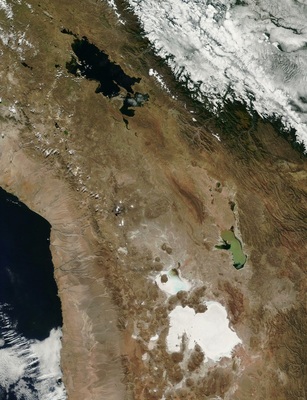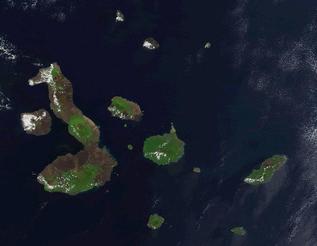Geographical settings
The Andes and Western South America

This is one picture, comes from outer space. It's a great image. At once, it shows Lake Titicaca, the high Andean Plateau, The Andes range and the and the Andes piedmont to the West. The differences in elevation are huge, from sea level in Chile-Peru, to up 5000 m (The Andes) to the average elevation of 3600 m of the High Andean Plateau.
The Lake Titicaca was part of a larger basin, probably including the Uyuni Salt flats to the South. Several Paleo-lakes have been described from the Pliocene to the residual lakes found today. One of the many organismal endemics characterizing the high Andean plateau are Telmatobius Frogs. I have studied frogs from Lake Titicaca, and surrounding areas and participated in the description of two new Telmatobius species, right on the border between Chile and Bolivia.
To the West a portion of the Atacama Desert is visible, this desert extends along Peru and Chile. Biogeographically, the area could be referred as the Peru-Chile Coastal Desert because it consists of one uninterrupted biome characterized by low diversity and high levels of endemism. One example of these endemics are Microlophus lizards, a clade of reptiles ranging from northern Chile to Northern Peru that has successfully radiated into several species within the Galapagos Archipelago.
The Lake Titicaca was part of a larger basin, probably including the Uyuni Salt flats to the South. Several Paleo-lakes have been described from the Pliocene to the residual lakes found today. One of the many organismal endemics characterizing the high Andean plateau are Telmatobius Frogs. I have studied frogs from Lake Titicaca, and surrounding areas and participated in the description of two new Telmatobius species, right on the border between Chile and Bolivia.
To the West a portion of the Atacama Desert is visible, this desert extends along Peru and Chile. Biogeographically, the area could be referred as the Peru-Chile Coastal Desert because it consists of one uninterrupted biome characterized by low diversity and high levels of endemism. One example of these endemics are Microlophus lizards, a clade of reptiles ranging from northern Chile to Northern Peru that has successfully radiated into several species within the Galapagos Archipelago.
Galapagos Archipelago

These are the Galapagos Islands Archipelago. Approximately 1000 Kilometers west from mainland South America. If you raft from the continent (As the majority of land vertebrates did) It will take about 20 days to make it to the islands. The Image shows the main Islands, but there are ~60 islands, islets and rocks here. All of them harbor life, and how island lineages evolved in isolation (or not) is one of the questions I like to think about.
I have been involved in several studies focused on the northern section of the larger and youngest island in the Archipelago. The Volcano Wolf in Isabela, harbors a large population of Chelonoidis tortoises characterized by a mixed origin. That is, founder events originated from different islands. More recently, we have studied founder events from the same source that took place at different times and described interesting consequences to the population dynamics in the Wolf volcano tortoise population.
I have been involved in several studies focused on the northern section of the larger and youngest island in the Archipelago. The Volcano Wolf in Isabela, harbors a large population of Chelonoidis tortoises characterized by a mixed origin. That is, founder events originated from different islands. More recently, we have studied founder events from the same source that took place at different times and described interesting consequences to the population dynamics in the Wolf volcano tortoise population.
